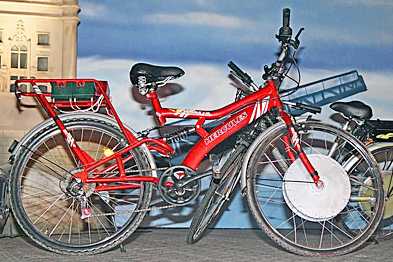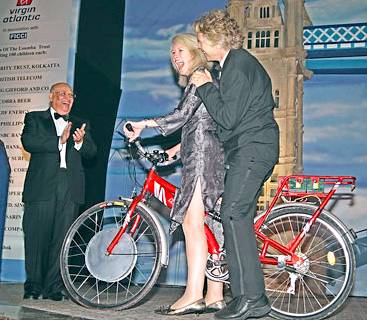Bike maker heads for electric avenue
The electronic bike is going to try for widespread acceptance once again, but this time in the countries where it might be needed most.
Ultra Motor, a start-up based in the United Kingdom, will launch a new type of electric motor later this year that the company hopes will help jump-start the theoretically lucrative but highly elusive market for personal transportation and clean vehicles.
In September, two of India's largest bike manufacturers will come out with bikes equipped with the company's AH300 motor, which will run for 35 kilometers (21.75 miles) on a single charge and run at a top speed of 25kph (16 mph). Billionaire Sir Richard Branson auctioned off the first two prototype bikes at a charity event in 2004.
Ultra Motor is also working on more powerful versions of the motor that could appear in rickshaws (still a major form of transportation in India, Vietnam and elsewhere), wheelchairs, motorcycles, small cars and hybrid vehicles. In tests, the company has cranked the speed of vehicles using its engines up to 56mph.
Ultra motor powred electric cycle
Ultimately, vehicles powered by the company's motors could well be targeted at environmentally conscious, bike-happy regions such as the Netherlands. "We looked at the Segway experience. They tried to change the behavior of the customer," said Joseph Bowman, senior investment manager at venture firm Russian Technologies and formerly the interim CEO of Ultra Motor. "We're positioning the company in the niche between a bike and a scooter."
For several years, personal vehicles like the Segway Human Transporter and the Zap PowerBike have been waylaid by potholes. This time around, however, the circumstances favor the growth of the market.
For one thing, the price is lower, Bowman said. Complete Ultra Motor-powered bikes will sell for about $150 to $175, far less than the Segway, which runs a few thousand dollars, or many electric bikes, which can cost about $1,000. Recharging the motor costs about 6 cents, he added. The attitude of governments has also become brighter. In 2001, New Delhi swapped diesel buses for natural-gas ones, and several other Indian cities are taking steps to adopt nonpolluting public vehicles. Indian cities are also looking at offering subsidies to buyers of electric cars such as the Reva, an e-car developed by an Indo-American joint venture.
In the United States and Europe, motorized two-wheelers that top out at about 16mph are typically classified as bikes under pending and recent regulations, meaning that the company can skirt driver's license and registration laws. Because the vehicles are bikes, the sidewalk-driving controversy that saddled Segway can also be avoided. Rising energy prices, pollution and fears of global warming are growing in importance as factors, too.
Chinese consumers have already shown that the concept has some legs. In the past four years, about 3 million motorized bikes have hit the road in China, starting from a base of zero, Bowman said.
A Cold War hangover
Ultra cycle motor and Richard Branson
It wasn't until 2003 that Flintstone Technologies, a British venture capital firm whose directors include a former professor of Moscow State University, funded the project. Russian Technologies, the venture arm of the Russian conglomerate Alfa Group Consortium, invested in Ultra Motor in 2004. Silicon Valley VCs met the company during a tour of Russian start-ups last September. The motor consists of a stationary permanent magnet attached to a hub and surrounded by three pairs of electromagnets. Those magnets are embedded in a rotating cylinder, which is attached to the wheel. Rapidly changing the polarity of the electromagnets from positive to negative causes the wheel to propel itself forward.
"The power from the motor is controlled by varying the pulse duration of the voltage. As rotation speed increases, both the on and off pulses will get shorter, but the proportion increases," Martin said. "The basic principle of electromagnetic propulsion--opposite poles attract, and like poles repel each other--is true of both our e-bike motors and the Maglev magnetic trains found in Japan."
Competing electric motors also rely on electromagnetism but aren't as efficient, Ultra Motor says. The design of its engines, it claims, can generate 50 percent more torque, or force around a pivot point, than competing motors, or get the same performance on less battery power. In addition, the company's motors contain only five main components and one moving component.
Like other electric vehicles, bikes equipped with an electromagnetic motor are fairly quiet. They can also be started from a dead stop or accelerated through pedaling. In Europe, however, bikes will have to be started through pedaling: A two-wheeler that can start on its own motor typically gets classified as a motorcycle.
TI Cycles of India, based in Chennai (formerly Madras), and Avon Cycles, based in Ludhiana, are slated to release complete bikes using Ultra Motor's technology in September, Bowman said. Because the motor is fairly slim, the bikes themselves are constructed around a standard urban bike frame, he added.
At $175, the bikes will cost more than a top-of-the-line pedal cycle, which sells for about $50 in India, but will cost far less than a $500 scooter, Bowman noted. Recharging the motor is also cheaper than using diesel fuel would be. The AH300 will be able to propel a payload of 264 pounds, Bowman said. Subsequent motors for rickshaws will be more powerful, enabling the bikes to take on more weight.
|

